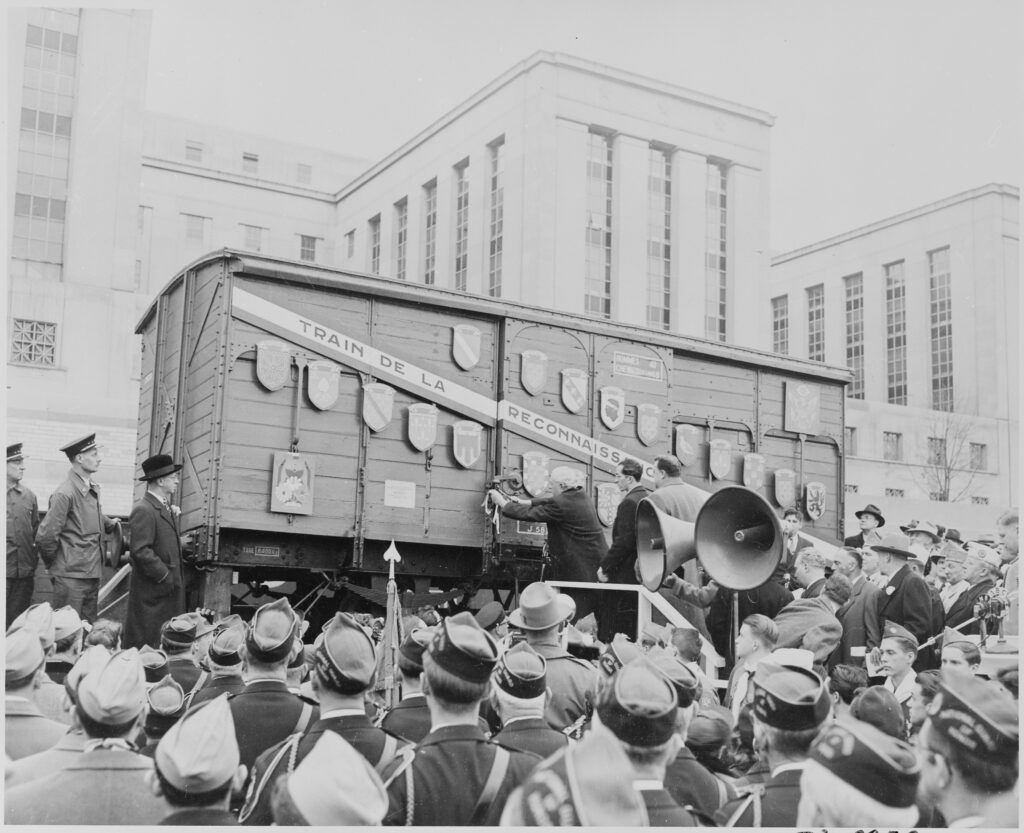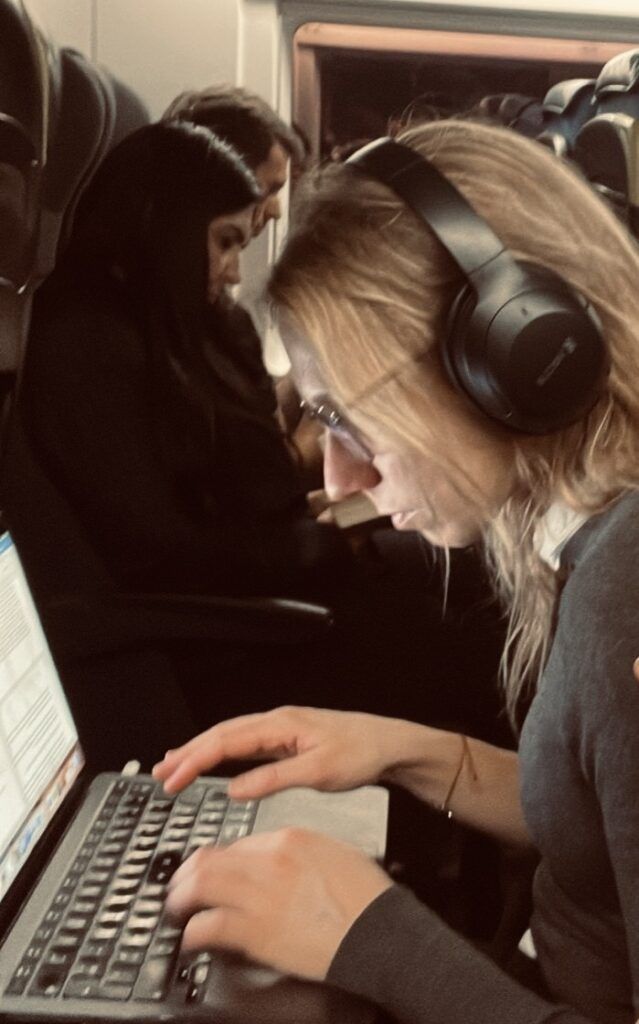Among other things, Ludivine Broch is a founding editor of the French History Network and Lecturer in History at the University of Westminster. She joined us to talk about her new article in the latest issue of French History, which she co-edited.
Hi Ludivine, thanks for joining us to talk about your new article. What do you think will most surprise readers in what you have to say?
I think most people will not have heard about the Train de la Reconnaissance, and it will surprise them because the French have a reputation for their anti-Americanism after the war, and even their ingratitude. Resentment for the intense Allied bombings was mixed with frustration at the behaviour of the GIs. Works like that of Mary-Louise Roberts have highlighted so well this very real tension between the American soldiers and French civilians.
They’ll also be surprised because France was struggling so very much after the war, and here she is, sending 52,000 objects to the United States! It sounds completely over the top as well as unexpected.

Do you have a favourite example or anecdote you came across in this work?
One woman sent a doll, and although I was not able to find the doll, I have the letter and photograph she sent alongside it. The photograph is of a little girl, the name ‘Edna’ written on the back. She is still a baby, learning to stand by holding onto a small tree. In her letter, the donor thanks the Americans for their aid and the liberation in 1944; and then, in simple sentence towards the end, she explains who Edna is: it is her daughter, who she had with an American soldier who she never saw again. The photograph becomes so loaded, so layered, so tragic – I find it incredibly powerful. I’m keeping this story for the book!
What’s the thing you most regret having to leave out of this piece?
The whole gesture of gratitude is deeply gendered, and the photographs of women in swimming costumes hanging on to the Gratitude Train boxcars are part of a bigger story about gender and gift-giving. Another for the book!

Can we talk about the backstory to the article? How did you first get interested in this topic?
This article comes from a collaborative project with Andrew and Will, when the three of us talked about taking the objects in our research more seriously, and to see what happens when they are placed at the centre of our analysis.
When I turned my paper into an article, I decided I really wanted to play around with the study of material culture here, to ignore (to an extent) the broader context and significance of the Train. Basically, to zoom in and think: what do these objects tell me? What do they do?
Reading works in anthropology and material culture studies made me want to adopt a very traditional object-centred approach and see where that led me. I really enjoyed choosing the three objects, explaining how I worked with their materiality, and using that to shape the different sections.
But for the petite histoire of how I got interested in this topic: I was having a slow day in the archives of the Haute-Garonne and saw a dossier in the catalogue entitled ‘Train de l’Amitié’.
I was intrigued, ordered it, flipped through it, and thought ‘this is pretty cool’. I photographed the whole file and put it in a safe space in my desktop for another time. This was 2011; four years later, I was doing bits and bobs of archival work during my new-born’s lunchtime nap, slowly going over some files in order to do something other than clean baby grows.
I picked up the Train de l’Amitié file and started taking notes: turns out, this Friendship Train sent by Americans to French people in 1947 had generated another massive train in return. This was of course the Gratitude Train, sent this time from French people to Americans, with 52,000 objects in it! I was immediately intrigued by the bits of lace, dolls, wedding dresses, silverware and more. I decided to focus on the Gratitude Train in order to fully explore the material culture, but also emotions, of the post-war period.
Are you a ‘plan it all in detail’ writer, or a ‘start writing and see where it goes’ person?
I love a good plan and find this a really useful way to organise daily writing habits.
But at times I end up down an archive rabbit hole, and I am writing as I research and the words then flow particularly fast. When I re-read them I don’t always keep everything – in fact, pretty much everything I write turns into a re-write – but generally they’ve offered me a slightly new and different direction.
Do you have a cure for writer’s block? We ask everyone this question because we live in hope.
I used to have it terribly, so I got into a habit of daily writing for short periods at a time. I cannot do this consistently throughout the whole year, but I try to. It means I can keep up with my writing during term time, and gets me into the habit of just putting words down on a page, and then fixing them later.
I’m more convinced than ever about the fact that you ‘write to think’.
Other thing I do: put big headphones on. Sans music.
Best case scenario: it cancels out background noise/muffles.
Worst case scenario: hides a bad hair day.
Whose writing do you most admire and why?
Well, there are a few which are currently on my mind. I’m reading Julian Jackson’s latest book on Pétain at the moment, and I loved his de Gaulle biography before that. Both have a brilliant narrative arc, are dense with research and knowledge, offer a highly comprehensive overview of the bigger picture, but are also peppered with rich, often humorous detail which is never anecdotal and always enlightening.
I was enthralled when I read Montaillou, where Le Roy Ladurie guides us in the careful dance of archival research, and of the past. I find Henry Glassie’s clear and simple writing style very effective and deeply moving, and my recent encounter with Mark Smith, who writes about the sensorial world of American history, has been hugely inspiring.
I also love to read fiction and non-academic non-fiction. I really like Clover Stroud, who writes with intensity and urgency, and creates an intimate connection with the reader.
What do you think helpful feedback on writing involves?
All feedback is helpful, as long as it doesn’t crush you. As a former editor I’ve seen this so many times, where reviewers almost attack an author for the content as well as the form. It’s awful to read. Helpful feedback should elevate, not deflate. Suggestions to re-organise the structure, identify topic sentences, or highlight specific elements of an argument over others are often very helpful and can transform a piece.
What’s the word you can never type right?
Weird. Or is it wierd? I think it’s weird, but I live in doubt.
What are you working on next?
I’m writing a long (long!) prologue to a memoir being translated in English and published with Pen & Sword.
It’s the memoir of an anti-fascist resister, Francesco Nitti, who resisted in Toulouse, was interned in Le Vernet for over a year, and was deported on the ‘train fantôme’ in July 1944. He jumped from the train and managed to escape just before the German border. A few months later, he wrote about his ordeal of having spent 54 days (!) in that deportation convoy, the longest deportation journey from France by a long shot. (Clearly I can never escape trains.) But this project is a bit different, and aimed at a very different audience. I’m writing a short overview of Vichy France to give English-speaking readers some historical context, and then diving deep into his own life history before suggesting a sensorial history of deportation which his memoir reveals. It’s such a fun project, and I’m almost at the end. After that, it’s time to write the Merci Train book. I’m excited about spending the summer thinking not just about what to write but how to write it.
If you could see one change in academia in the next five years, what would it be?
Post-92 universities have really struggled with the lifting of caps on student numbers since the rise in fees. Some departments are overflowing with students, bringing on huge amounts of extra work on the teaching staff; others see dwindling numbers and their jobs are on the line.
So in the immediate, it’d be capping numbers, so that we in post-92s can teach more students, and so that students can enjoy all the great teaching experiences outside the Russell Group.
Éclair or saucisson?
I’ll take a nice slice or two of saucisson placed on freshly-torn piece of baguette tradition and a thick slab of butter; followed by an éclair au café, of course.
To keep it all nice and balanced, I’d probably add a tub of salade carottes rapées in the middle there, the ones in small plastic containers that they sell in every French superette. (I’m obsessed with those).


